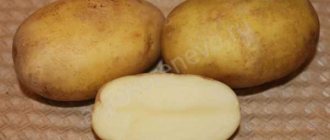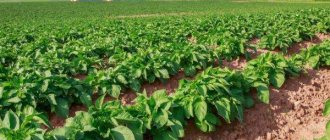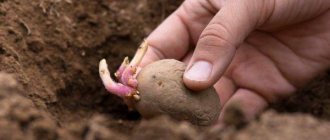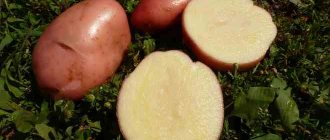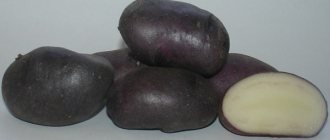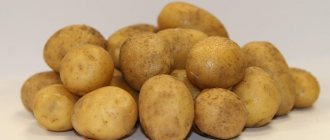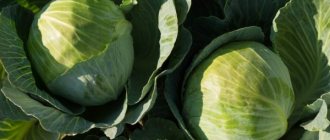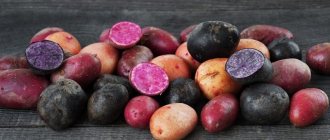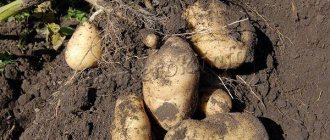Potato volante variety description photo reviews
Nov 15 • Uncategorized • 144 Views • No comments on the entry Potato volante description of the variety photo reviews No
Contents
General characteristics: table, mid-season potato variety of Belarusian selection. Resistant to drought and mechanical damage. It is distinguished by a high content of useful substances in the pulp. Adapts to soil and climate.
Ripening period (vegetation): 80-95 days.
Starch content: 11.2-19%.
Weight of marketable tubers (grams): 90-180.
Number of tubers in a bush: 8-15 pieces.
Productivity (c/ha): up to 624.
Consumer qualities: good taste, average digestibility, culinary type B. The pulp contains a high concentration of protein and vitamin C. Ideal for frying and baking.
Keeping quality (storage ability): 96%.
Peel color: yellow.
Flesh color: yellow.
Preferred growing regions (RF): light to medium soil texture.
Disease resistance: the variety is resistant to nematodes, potato canker, viruses, scab, blackleg, rot, rhizoctonia, alternaria, late blight on leaves. Tubers are affected by late blight.
Features of cultivation: germination is recommended, standard agricultural technology.
Other: the originator of the Volat potato variety is the Scientific and Production Center of the National Academy of Sciences of Belarus for Potato and Horticulture.
Today, potatoes are included in many dishes. At the moment, potato crops are rapidly appearing in almost every household plot. Many gardeners have stopped buying ready-made products at markets, because growing and caring for root vegetables is very simple and interesting. There are various types of potatoes that gardeners choose depending on the requirements for growing conditions and the result they want to get. The most famous and unpretentious species at the present time remains the Volat potato.
Volat potato variety
Description and characteristics of the variety
Volant potatoes belong to the type of mid-season varieties. The harvest is dug up after 75–100 days. The bushes are medium-sized, the stems are strong, they do not lie down, the arrangement is erect. The flowers are white, collected in inflorescences. There are few berries.
Features of tubers:
- shape - oval, elongated;
- average weight - 90–160 g;
- starch - 11.2–19%;
- eyes - not numerous, set 1–2 mm deep, reddish;
- the skin is yellow, strong, the flesh is yellowish;
- high level of ascorbic acid (29–30%).
The State Variety Commission assessed the consumer and taste qualities of the Volant variety at 4.7 points.
Culinary type - B. Shows moderate friability during heat treatment. Suitable for frying, baking, mashing. It is used in large quantities for the production of chips, the preparation of semi-finished products, and the production of potato starch and mixtures. Keeping quality - 94–96%: potatoes keep well until spring.
The Volant potato was created by Belarusian breeders on the basis of the National Academy of Potato and Vegetable Growing. The date of entry into the State Register of Russia is 2014. Culture is in consumer demand.
Characteristics of potatoes
The Volat variety, or popularly simply Volot, is a new variety of Belarusian selection.
The description states that volat potatoes are a mid-season table variety. Suitable for cultivation on light and medium-textured soils. The proposed planting saturation for sale is 48-52 thousand tubers/ha, in seed fields - 55-58 thousand tubers/ha. Volat tolerates drought well and, despite the fact that it is a new variety, has excellent keeping quality. The dormant period of tubers is average. Volat is not subject to mechanical damage. Productivity up to 62.4 t/ha.
The fruits are oval-shaped, yellowish, the eyes are small, red. Blooms with white inflorescences. The nutritional properties are excellent, used for type B cooking. Starch is contained in an amount of 11.2-19.0%. This type of potato is characterized by a good content of vitamin C - 29.9%. Also in the fruits one can note the abundant protein content, which establishes its great biological significance.
Advantages of the Volat variety
- Tolerates drought well.
- Potatoes have an average physiological dormancy period for tubers.
- Resistant to injury.
- Has good keeping quality.
Many summer residents who have repeatedly planted potatoes in their gardens speak only positively about the new variety of volat. Low costs, minimal effort during planting and harvesting, and, in addition, rational resources spent in processing, give volat the opportunity to gain an advantage over many varieties.
People’s impressions of its nutritional properties expand the list of advantages of this type. The delightful taste properties and attractive appearance of the tubers give an excellent idea of the volat variety.
Review of the best varieties
The main thing in potato cultivation is the targeted application method. Both table fruits and fruits for technical needs are grown. A crop rich in starch, which is consumed as food and used as livestock feed, has gained popularity. The following categories are distinguished:
- Category A includes varieties that are used in salads. They are characterized by a strong pulp structure, do not overcook, and are watery.
- Category B is applicable for preparing first courses, frying, and boiling. The structure of the pulp is dense, not very boiled, not watery.
- Category C – types for first courses, purees, moderately mealy, well boiled.
- Category D – the most easily cooked types, suitable for pureeing and baking, the structure is very soft and mealy.
Early
Early potato varieties of Belarusian selection are cultivated mainly in climatic zones with stable weather conditions.
Most of these species are popular for cultivation in Russia and Ukraine, since the average annual temperatures and soil composition are similar to those in Belarus.
Zorachka Potatoes
The early-ripening variety, like the Temp potato, is zoned for moderate weather conditions. Main characteristics:
- ripening period from 45 to 75 days until technical maturity;
- oval tubers with smooth dark yellow skin, whitish flesh, few eyes;
- non-watery starchy taste of the pulp, starch content within 13%;
- tuber weight up to 120 g, up to 10 pieces can develop under one bush;
- keeping quality up to 96% - a high indicator for early ripening varieties;
- yield per hectare – 40-70 tons;
- does not tolerate dry periods well, is resistant to various diseases, grows on any type of soil with neutral acidity.
Although this type is not suitable for subsequent winter storage, it is ideal for preparing fresh dishes. Ripens early, is unpretentious to climate change, requires simple care, and has a rich taste. In addition, the tubers are transportable and can withstand any mechanical damage.
Dolphin
Table type, included in the State Register for the northwestern region. Originators: TsKB-Agro, Scientific and Production Center of the National Academy of Sciences of Belarus. Description:
- the bushes are low, have an intermediate growth habit;
- stems are massive, not colored;
- the flowers are white, divided into wide lobes;
- leaves are dissected, medium in size, the edges are not wavy;
- average yield per hectare – 540 centners;
- the skin is yellowish, smooth, the tubers are oval, round or elongated, weighing up to 110 g;
- pulp with a yellow tint, starch up to 14%;
- the time period from planting to full maturity is 2.5 months.
The advantages include:
- marketability up to 96%;
- pleasant taste;
- early harvest;
- attractive appearance of tubers, a small number of eyes;
- keeping quality from 90% and above;
- 100% immune to nematodes.
Preparing tubers for planting
Ideally, seed potatoes must be selected in the garden. Walking through the beds, with a keen eye, highlight strong and good-quality bushes. Mark them with pegs or a tag. These bushes must be dug up separately and the middle fruits must be selected from them for seeds. For breeding, fruits weighing 40-60 grams are good. In order to plant large potatoes before cutting them, you need to adhere to certain parameters.
First, you should divide the potatoes so that at least three eyes remain in one half. Then, after any cut of the root crop, the knife must be treated with a solution of potassium permanganate (dipped in a vessel with this substance). The problem is that during this operation, the threat of infection of the fetus with viral and enterobacterial diseases increases.
Sprouting potatoes for planting
To harvest early potatoes, experts recommend germinating and greening them first. The description states that this method also helps to increase the immunity of potatoes. A sprouted species can be planted earlier; it will not be as susceptible to disease as a non-sprouted species. 3-4 weeks before disembarkation, you need to start this procedure. For this purpose, potatoes are poured into boxes in one or two rows and brought into a place with a temperature of 15-20 degrees, while at night, the planting material must be removed to a place where the potatoes will be fresher (basement or garage), in which the night temperature 5-8 degrees.
Tubers must be germinated before planting
To prevent the rudiments from being damaged, the fruits should not be exposed to direct sunlight (planting material requires diffuse light) - otherwise the rudiments will deteriorate.
By the end of the process, the germinated fruit will acquire a greenish tint, and green buds will appear on it, not exceeding 1-2 cm in length. This is a sign that the potatoes are ready for planting. Thanks to this procedure, it is possible to plant sprouted potatoes at a soil temperature of 5 degrees, while unsprouted potatoes can be planted at 8 degrees and above. Of course, the sprouts must be carefully monitored: they must be monitored to prevent unwanted growth in length. If you see that the sprouts have grown to the required length, and sow only after a couple of weeks (similar things happen), place the container with the sprouted potatoes in the cellar, then the germination process will slow down.
Recommendations for planting
If you sow potatoes in a garden where paprika, nightshade, tomatoes and other types of similar crops were previously grown, then harvesting a good harvest will be in question. These crops, like potatoes, are damaged by the same pests and diseases. For this reason, you need to plant volat where you grew peas, beans, cucumbers or onions last year.
Experts have found that the acceptable period for planting potatoes is when the ground at a depth of 10-12 cm warms up to 8 degrees. For the south of the Republic of Belarus, rational landing dates are formed in the second - third ten days of April, for the center of Russia - in the third ten days of April - first ten days of May, for the northern regions - in mid-May.
Vegetable growers' mistakes
The main mistake of vegetable growers is that when planting potatoes tightly, many believe that if they planted more fruits, the harvest will be larger. Actually this is not true. The ideal maintained distance is considered to be 30-35 cm. The explanation for this opinion is simple: nowadays, many tuber varieties are often formed, when 15 or more tubers are obtained from one unit of product.
During dense planting, such tubers come out small. It is also necessary to maintain a distance between the ridges of 60-70 cm. And to form a sufficiently high ridge, the potatoes need to be hilled two to three times. In addition, because of the high ridge, Colorado potato beetles and other harmful insects will not get on the potatoes, so your harvest will be perfectly preserved.
Landing
Planting in the middle zone begins at the end of April, when the soil warms up to +10–12 degrees and the risk of frost disappears.
Site preparation:
- Deep digging of the area in the fall and adding 5–10 kg of humus or compost per square meter.
- Digging up the bed in the spring. Add superphosphate and potassium sulfate according to instructions.
- Measuring soil acidity. If the pH is 5.5–6, the indicator is reduced with slaked lime, dolomite flour, ash or chalk.
- If the soil is heavy and clayey, loosen it with sand or peat.
Optimal predecessors: winter grains, green manure, legumes, cabbage, radishes and radishes, cucumbers, zucchini, pumpkin, carrots, garlic, onions, dill.
For planting, unrotten and undamaged tubers weighing 70–80 g are selected. They are laid out in the light for 2–4 weeks. The sprouts should reach 2–3 cm.
The holes are placed according to a 30 by 70 cm pattern. A little wood ash or nitrophoska and onion peels are placed in each hole.
Once every five years, it is necessary to update the variety by buying super-elite seed tubers or growing them yourself in seedlings.
Diseases and pests
Significant damage to the crop is caused by diseases such as stem nematode, rot and scab of various types. In most cases, key preventive measures can help prevent potato infections:
- After harvesting potatoes, it is advisable to grow lupins, winter crops, oilseed radishes, and mustard in this area, and then plow the vegetation into the ground for humus.
- It is good to plant types of potatoes that are suitable for the conditions of a given area.
- Fertilizers should be used in a well-rotted form (compost, humus); nitrogen fertilizers should not be used often.
- Gardeners should strive not to injure the tuber during the harvesting period, and those fruits that are spoiled should not be left for long-term storage.
- After harvesting, all potato tops must be dried and burned.
- It is recommended to create the necessary conditions in order to preserve potatoes with optimal temperature, humidity and good ventilation in the vegetable storehouse.
The description states that this species bears fruit well for many years and, with proper care, is not damaged by common diseases and pests. But the description of the variety also states that certain microbes can change the lifespan of potatoes. If ordinary potatoes or other vegetables that are not resistant to viruses grow in nearby beds, then viruses and insects have every chance of getting into your garden from this area along with aphids.
Belarusian potatoes Volat are grown both for personal use and for sale. Farmers respect the crop for its high fruiting rate, and in households, vegetables are valued for their excellent taste, high protein and vitamin C content. Despite its youth, the variety enjoys stable popularity and continues to join the ranks of its fans.
What kind of potatoes are these?
The young potato variety Volat is gaining popularity at a rapid pace. This is due to the high yield of the crop, increased resistance and excellent taste of the tubers.
Origin and development
The Volat potato variety is a new crop created by breeders from Belarus. Originator - Scientific and Practical Center of the National Academy of Sciences of Belarus for Potato and Vegetable Growing. It was included in the State Register of the Russian Federation in 2014.
Despite its short lifespan, the variety has already been chosen for commercial cultivation by hundreds of private entrepreneurs and farms. High yields combined with unpretentiousness could not help but attract the attention of those involved in vegetable growing with the subsequent sale of finished products. Farmers note increased consumer demand for vegetables not only in retail trade, but also in wholesale purchases.
Description of the variety and appearance
The purpose of ripe vegetables is for table use, average weight – 90-160 g, oval shape. There are few eyes, they are reddish in color. The peel is yellow, dense enough to protect the fruit from mechanical damage. The pulp is light yellow, the taste is high. Potatoes have a high content of protein, vitamin C (up to 30%) and other useful elements, which determines their nutritional value.
The starch content ranges from 11-19%. Ripe vegetables are ideal for frying and baking. The friability is moderate, so the tubers are often used for boiling and making purees.
Potatoes are purchased by large enterprises for further processing to make chips and fast food products. Vegetables are also used to produce starch.
The variety is suitable for long-term storage, shelf life is 94-96% of the total volume. During long-term transportation, the tubers retain their taste and presentation.
The photo shows Volat potatoes.
Description of the variety
High yield is one of the main advantages of the variety. Farmers harvest about 600 centners of potatoes from one hectare. This makes the Belarusian Volat culture in demand in Russian fields and fields of its closest neighboring states. Full ripening occurs 90–95 days after planting in open ground.
For your information! The harvest consists of beautiful fruits that are resistant to mechanical damage and retain their marketable appearance for a long time.
Disease resistance
The variety is not afraid of diseases such as potato canker, all kinds of viruses, fusarium rot and anthracnose. Immune to golden nematode attacks. Late blight and field mice are also dangerous for Volat potatoes.
What are Volat potatoes?
Characteristics of Volat potato tubers
Volat potatoes are table varieties. The approximate weight of one fully ripened root vegetable ranges from 90 to 160 g. The potatoes are oval in shape, have a dense yellow skin with a small number of reddish eyes. The pulp of the tubers is pale yellow. The starch content does not exceed 19%.
The medium-height potato bush is distinguished by a powerful trunk and a well-developed root system. The foliage of the Volat potato variety is colored juicy green and is medium in size. During the flowering period, small corollas of white flowers appear.
For your information! Russian and Belarusian chefs characterize the taste of Volat potatoes as high-level.
Potatoes can be stored for a long time and transported for a long time. In the process, it does not lose its taste and presentation.
What regions is it suitable for?
The crop takes root well and bears fruit on light, fertile Russian and Belarusian soils, as well as in the fields of Kazakhstan, Ukraine and Moldova.
Taste qualities
In cooking, Volat potatoes are used for frying, boiling and baking. The variety is also suitable for making mashed potatoes, since the finished potatoes become crumbly.
Volat potatoes are used in cooking in many dishes
Note! The main buyers of this variety of root vegetables are large processing enterprises specializing in the production of chips, fast food and starch.
Plant characteristics
The bush is of medium size, the stem is powerful, the root system is well developed. The leaves are medium-sized, rich green in color. When flowering, medium-sized white flowers are formed, collected in neat corollas.
The ripening period is average; tubers reach full technical ripeness 85-95 days after planting . The variety adapts well to drought, but is not resistant to frost.
Plants are immune to golden nematode, potato canker, diseases of viral etiology, fusarium rot and anthracnose. However, the variety does not have resistance to late blight, so preventive measures are needed.
Productivity
Productivity is the main advantage of culture . Up to 600 centners are harvested from 1 hectare, which is an order of magnitude higher than other high-yielding varieties. Therefore, Volat is a welcome guest on numerous Russian fields and in neighboring countries.
All fruits are beautiful, leveled, and resistant to damage. 98% of finished products retain their presentation.
How to grow potatoes
The technology for growing potatoes comes down to standard procedures. The crop requires proper watering, timely fertilizing and hilling. The plant quickly adapts to the soil composition and climatic conditions.
Pre-sowing preparation
1 month before planting, tuber preparation begins. The optimal weight is no more than 100 g. Large tubers are pre-cut into slices.
Potatoes are carefully inspected and damaged ones are removed. The remaining seed material is laid out in a bright room for germination. Only sprouted tubers are planted, otherwise there will be no shoots. Optimum room temperature +15…+17°C.
Before sowing, the tubers are treated with a growth stimulator. The drug accelerates the emergence of seedlings and protects potatoes from fungal diseases. The most commonly used are Epin, Kornevin and Bioglobin.
By the end of germination, the tubers may acquire a greenish tint. This indicates an increased accumulation of solanine in the peel. The substance is a glycoside with toxic properties. It is best to plant green potatoes: thanks to solanine, the seed material will be reliably preserved from rodents.
Reference! Field mice are the most dangerous for planted potato tubers.
Dates, scheme and rules of planting
Volat loves light but fertile soil, so it is important to saturate it with useful substances before sowing. It is prepared in the fall by digging with the addition of humus and wood ash. In the spring the procedure is repeated. Digging not only loosens the soil, making it lighter, but also destroys the larvae of parasitic insects and fungal spores.
Planting begins in late April - early May, when the soil warms up to +10°C and the daytime temperature reaches +16...18°C. If there is a threat of return frosts or heavy rains, it is better to postpone planting so as not to ruin the seed.
Planting pattern: 35 cm – distance between holes, 70 cm – row spacing. If these conditions are met, the plants are easy to care for, they are ventilated and receive enough light, which prevents the spread of pathogens.
Potatoes are placed in holes no deeper than 10 cm. A little wood ash is placed at the bottom and sprinkled with soil on top.
Reference! When cutting large potatoes, leave at least three sprouts on each slice, otherwise there will be no sprouts.
Further care
The culture is unpretentious in care and does not require constant attention or a lot of time and effort.
Watering
Seedlings need abundant watering during flowering and fruit formation . But do not forget about the plant’s susceptibility to late blight. Excess moisture promotes the spread of fungal spores and their rapid development.
The best watering is drip. With such irrigation, the roots will not experience a lack of moisture, and the humidity level in the beds will always remain within normal limits.
After watering, loosening is carried out. Loose soil improves oxygen access to the root system, which has a beneficial effect on the development of seedlings.
Weeding beds is a necessary preventative measure in pest control. In addition, the growth of weeds consumes useful elements necessary for the life of seedlings. Weeds are removed with roots, and the beds are mulched. Mulch retains moisture in the beds and prevents the growth of new weeds.
Reference! Peat and straw are most often used as mulch.
Hilling is carried out three times per season. The procedure begins as soon as the seedlings reach 10-12 cm. The soil from the rows is raked onto the seedlings. The higher the hilling is carried out, the more the fruits are protected from sunlight and pest damage.
Feeding
Fertilizing improves crop productivity and strengthens immunity. The first one is applied as soon as the seedlings grow to 20-25 cm. If the growth of the bushes is poor, they are fertilized earlier. To do this, use nitrogenous substances or ammonium nitrate.
The second feeding is carried out at the time of flowering. During this period, seedlings need organic matter. The culture responds well to the application of bird droppings in a ratio of 1:10. The solution is spilled between the rows, after thoroughly moistening the soil.
The third time they are fertilized with a full complex of minerals. This fertilizing is applied 1 week before fruiting. Phosphorus elements and potassium substances are especially effective.
Reference! The introduction of nitrogen accelerates the growth of bushes and the growth of green mass.
Disease and pest control
The most effective and popular fungicide in the fight against late blight is Fitosporin. In addition to therapeutic, it also performs a preventive function. Many gardeners spray seedlings with this preparation from the beginning of planting. This preventive measure guarantees the health of plants in your areas.
In addition to Fitosporin, gardeners use wood ash, which is sprinkled on the bushes. It protects plants not only from fungal diseases, but also from many pests.
To combat the Colorado potato beetle, the drugs “Confidor” or “Prestige” are used, and the insecticide “Aktara” is used to control potato aphids. Another effective remedy is tobacco infusion, the smell of which repels not only aphids, but also whiteflies. The solution is prepared simply: 500 g of tobacco is dissolved in 1 liter of water and boiled for 1 hour. The concentrate is diluted in 10 liters of water and sprayed on the plants.
Reference! The natural enemy of aphids is the ladybug. Plant dill in your area to attract beetles. The ladybug actively destroys aphids until autumn.
How to properly care for the variety
The culture is unpretentious in care and does not require constant attention or a lot of time and effort.
The potato field needs to be hilled up and weeded from weeds.
Features of watering
Plants will need generous watering during the flowering and fruit formation stages. When watering, it is worth remembering that the crop is not resistant to late blight and try not to pour too much water onto the beds. The best watering method for Volat potatoes is drip irrigation.
Important! Each regular watering is completed by loosening, ensuring access of oxygen to the root system of the planting material.
Feeding and fertilizing
Application of fertilizing helps to increase the immunity of the crop. The first feeding is carried out after the seedlings reach a height of 20 cm. If the potato bush is lagging in growth, it is fed ahead of schedule. Treatment is carried out with nitrogenous substances or ammonium nitrate.
Collection, storage and use of crops
Before harvesting, it is advisable to mow the tops. The foliage is burned because it may contain pests.
Potatoes are dug up with a pitchfork or shovel, then left on the site for 2-3 hours to dry completely. The harvest is then placed in wooden boxes for storage. The room chosen is dry and cool.
The shelf life of the finished product is high; almost the entire harvest retains its presentation until spring.
Ripe tubers are used in cooking as widely as your imagination dictates. The fruits are ideal for preparing any dish, including baking and stewing.
Large enterprises purchase potatoes for further processing and production of chips and fast food. The tubers are also used to make starch.
How to harvest and store crops
Potato harvesting begins after the tops are mowed. The cut foliage is burned to rid the plants of the pests that have settled there.
Potatoes are dug up using a fork or shovel. The harvested crop is left in the garden to dry. After 2–3 hours, the dug potatoes are transferred to a wooden container and stored in a cool, dry room.
Potatoes are best stored in the cellar
Thanks to the excellent keeping quality of Volat potatoes, the crop, collected and stored for storage in accordance with the instructions above, will be stored until spring without losing its presentation.
Advantages and disadvantages
Among the many advantages of the Volat variety:
- possibility of breeding in all regions;
- adaptation to drought and soil composition;
- possibility of quick implementation;
- ease of care;
- high resistance;
- increased productivity;
- excellent taste of fruits;
- long preservation of presentation;
- duration of transportation;
- universal application.
One of the negative qualities is susceptibility to late blight.
For which regions is it best suited?
The culture has become widespread in Russia, Belarus, Kazakhstan, Ukraine and the Republic of Moldova. But it is preferable to plant the variety in regions with light and fertile soil.
Farmer reviews
Reviews about potatoes come not only from Russian gardeners, but also from neighboring countries. Here are some opinions:
Ilya, Minsk: “From the characteristics of Volat potatoes it follows that all agricultural technology comes down to several standard procedures. The way it is. I am a farmer, I have been growing vegetables for a long time, and minimal costs for cultivating fields are very important to me. Ripe vegetables are in excellent demand. The taste of potatoes is amazing, so I not only sell the harvest, but also definitely keep it for the winter.”
Ekaterina, Moscow: “Last year I saw a photo on the Internet, read the characteristics and decided to plant it on my site. I have a small garden, so I always wanted a productive crop. Volat did not disappoint. There were a lot of potatoes, all smooth, beautiful and tasty. I recommend it to everyone."
